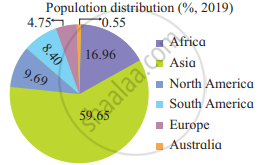Advertisements
Advertisements
प्रश्न
Analyse the economic factors affecting the distribution of population in the world.
उत्तर
The effects of economic factors on the distribution of the world population are as follows:
- Minerals: Areas rich in minerals attract industries. Mining and allied activities generate employment. Skilled and semi-skilled workers move to these areas, making them densely populated. Eg. Katanga Zambia copper belt in Africa.
- Industrialization: Industrial belts provide job opportunities and attract large numbers of people. These include factory workers, transport operators, shopkeepers, doctors and other professionals.
Eg: The Kobe - Osaka industrial region of Japan. - Urbanization: Better employment opportunities, educational and medical facilities, and better means of transport and communication attract people to cities. It leads to rural-urban migration, and hence cities grow in size.
E.g. prominent, many people move to cities like Delhi, Mumbai, etc., making them densely populated.
APPEARS IN
संबंधित प्रश्न
Give a geographical reason:
Population distribution is uneven.
Physical factor affecting on the distribution of population is ______.
Complete the chain.
| Sr. No. | A | B | C |
| 1. | Australia | Dense equatorial forest | Highest population |
| 2. | Amazon basin | Coastal region | Sparse population area |
| 3. | East America | Desert | High population |
| 4. | India | Permanently snow covered | No residential population |
| 5. | Antarctica | Monsoon climate | Low density |
State whether right or wrong:
Least population is found in continent of Australia.
State whether right or wrong:
Population density is high on Tibet plateau.
State whether right or wrong:
Population density is high in polar region.
Differentiate between
Rural and Urban composition of population
Write short note
Effect of relief on population distribution
Draw diagrams and label it
- Expansive age–sex pyramid
- Circular pattern settlement
- Classification of tertiary economic activities.
Which one of the following states has the highest density of population in India?
What was the annual growth rate of population in India as per the 2011 census?
How much percent of World’s population is in India?
Write a short note on:
The third stage of population transition theory
Which state has the largest population?
Which of the following is not the area of large population concentration?
Which of these factors are responsible for uneven distribution of population in India?
- Climate and terrain
- Development of transport network
- Concentration of natural resources
Consider the following statements and choose the correct option from the given options.
- It is observed that the North Indian Plains, Deltas and Coastal Plains have higher proportion of population.
- The interior districts of central Indian states and Himalayas also have higher proportion of population.
Observe the following diagram and answer the questions given below.
 |
|
- Which continent has the least population?
- Which continent has the least landmass and also the least population?
- Which continent has the most landmass as well as most of the population?
- Which continent is missing in one of the pie charts? Why?
- What is the percentage of population distribution in Asia?
Population distribution is same everywhere.
"The uneven spatial distribution of population suggests a close relationship between population and socio-economic and physical factors." Analyse the statement.
Analyse the effects of geographical factors on the distribution of world population.
Analyse the social factors affecting the distribution of population in the world.
Draw diagram and label it.
Expansive age – sex ratio.

